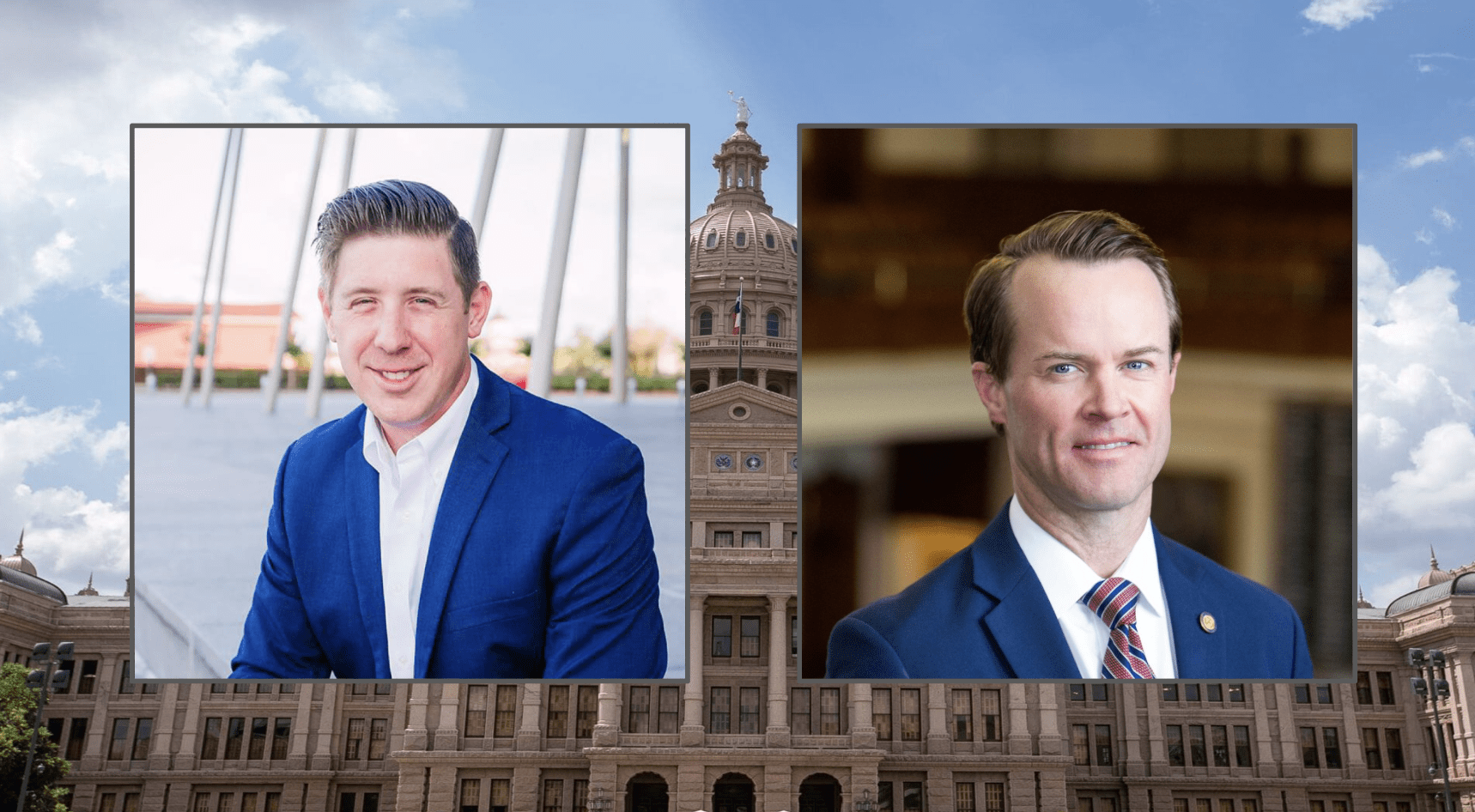Struggling taxpayers are funding lucrative salaries at government schools. These institutions are indoctrinating students, failing to educate them, and opposing citizens.
The Texas Constitution guarantees government education. It doesn’t require bureaucrats in the system to be excessively well paid while running an insurgency against Texans. Excessive pay in state and local government was the focus of Part 1 of this investigative series. Combining this with the state’s education failures, and a possible incoming recession, heightens the need to address this matter.
“I do see that in the second half of 2023, the national economy is going to take a bigger plunge,” said economist Vance Ginn of Vance Ginn Economic Consulting. “The second half of 2023 is going to be pretty costly, as the Federal Reserve has raised interest rates and pulled money out of the economy.” He also noted that Congress raised taxes before the Republicans took over the U.S. House. “While Texas is able to withstand a downturn more than many other states will be, we’re not going to be immune to it. We’re going to feel the effects of it.”
This will be when taxpayers will need their state and local officials to ease their burdens, not hike them.
Call Back
In his 2004 speech to the Democrat National Convention, vice presidential nominee John Edwards spoke of two Americas: “one for people who are set for life, they know their kids and their grandkids are going to be just fine; and then one for most Americans, people who live paycheck to paycheck.”
This is more than just a national problem. In this series, records show there are two Texases: one for those connected to government and everybody else.
This dissonance extends to education, which has been a state government responsibility for many years. Regularly, the poor pay of frontline teachers is advertised. But instead of the earmarks of public service here for those at the very top of education, the trappings of taxpayer-funded high salaries are found.
For example, James Quintero of the Texas Public Policy Foundation pointed to the salary of the superintendent of Cypress-Fairbanks Independent School District: Dr. Mark Henry. According to the Texas Education Agency’s (TEA) database, he was paid more than $521,000 in the 2022-2023 school year, making him the highest-paid superintendent in Texas. “That is an astronomical sum of money when you’re talking about public tax dollars,” Quintero told Texas Scorecard. He added that Dr. Henry’s salary does not include other benefits such as healthcare, retirement, housing, or car allowances.
Quintero said there are more, like superintendents at Barbers Hill ISD (more than $466,000) and Isleta ISD (more than $442,000). “These are huge numbers when we’re talking about tax money.”
This raises the question of whether taxpayers are receiving a substantial return on their investment. Quintero said his preliminary findings, by comparing TEA salary data with their tracking of school performance data, show that is not happening. “In Cypress-Fairbanks ISD—which has the highest-paid superintendent—just 58 percent of its student population was able to read, write, and do math at grade level.” He also found these numbers to be 72 percent at Barbers Hill ISD, 47 percent at Isleta ISD, and 36 percent at Duncanville ISD.
Our research revealed these problems elsewhere.
Source Documents
For this article, Texas Scorecard reviewed state spending records on higher education from the Texas Higher Education Coordinating Board (THECB). We also reviewed records from them on the average faculty salary at government universities in Fiscal Years 2016 and 2022.
Records were obtained from multiple state and local education entities through the Texas Public Information Act.
Salary records from the University of North Texas in Denton and their most recent employment agreement with President Neal Smatresk were reviewed. We also obtained the presidential organizational charts for UNT (2015-2016 and 2022-2023)
Texas Scorecard also reviewed organizational charts from neighboring Texas Woman’s University.
We obtained salary information from:
Texas Scorecard also reviewed organizational charts from the Texas Education Agency (2016 and 2022) and 2022 salary information for certain high-level administrators.
This article contains highlights from these documents. Citizens wishing to conduct a deep dive should click the links above.
Universities
The vast majority of universities today have become subversive anti-citizen cells. Powered by the giant oil well of taxpayer monies, and other resources, they are actively indoctrinating students with propaganda and poisoning the well of our culture.
Below are some of the most recent affronts.
The University of North Texas (UNT) and the University of Texas (UT) offer classes on witchcraft. Texas Tech also did until a public outcry forced them to backpedal.
UNT also has been offering chest binders and fake genitalia for students to pretend to be the opposite sex. In May, investigative reporter Christopher Rufo found the University of Texas Austin was pushing the practice of polyamory. He earlier revealed Texas A&M was pushing the radical diversity, equity, and inclusion agenda (DEI). In April, a University of Texas professor promoted bigotry against “wealthy white men” in a quiz she offered. The same month, Texas State University was sued for allegedly threatening students’ First Amendment rights. Finally, UT was widely reported to have labeled conservative media as “disinformation.”
Even community colleges are not immune. In Part 3 of an investigation of wokeness in the Lone Star State, Texas Scorecard reported on Tarrant County College in North Texas pushing DEI. The Texas Legislature passed a law in 2023 to ban DEI in higher education, but there are loopholes.
These subversive institutions, marketed as “higher education,” are what state taxpayers are funding. And the money is flowing well. According to data from the Texas Higher Education Coordinating Board (THECB), the total funding allocated by the state Legislature for higher education in 2016-2017 was more than $13 billion. In 2020-2021, it was more than $14 billion. The data shows that education overall (higher education and K-12) continues to swallow up more and more of the state’s general revenue fund.
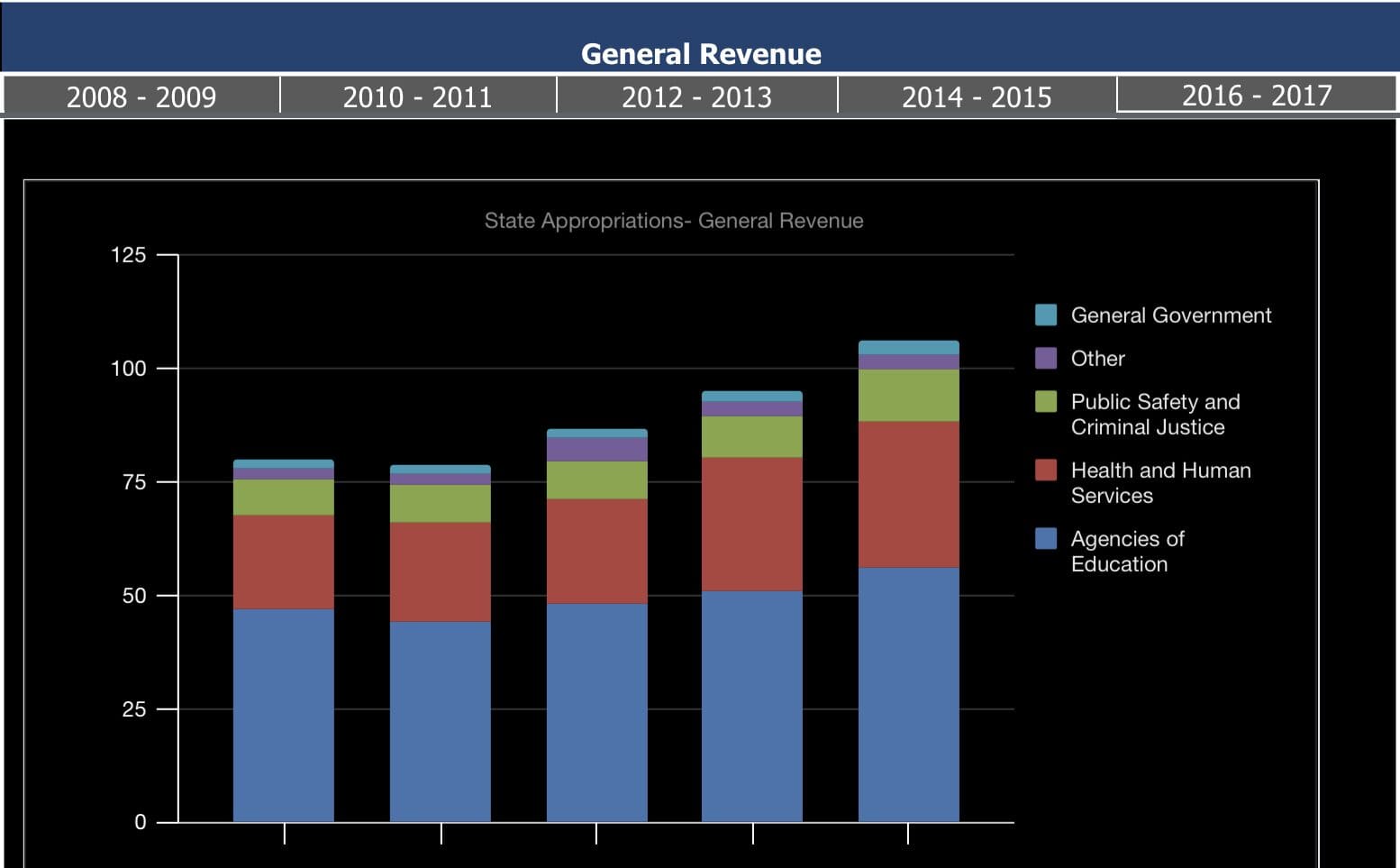
Source: Texas Higher Education Coordinating Board
THECB states that the Texas’ higher education has more money flowing to them outside of this—it’s not just from tuition, though. There are “some fees that do not flow through the appropriation process and revenue from auxiliary enterprises such as intercollegiate athletics, bookstores, dormitories, research grants, and other activities.” THECB also points out that public community and junior colleges “have other sources of revenue, such as local property taxes.”
None of this takes into account the donations that universities can accept. Texas Scorecard’s recent investigative series into the Bill & Melinda Gates Foundation and the Michael & Susan Dell Foundation found that both woke nonprofits have poured millions into Texas education, including universities.
In other words, despite the regular outcries from the government schools lobby, there is plenty of money. And there are those working in higher education who are living well.
Texas Scorecard sent an open records request to examine administrators’ salaries at the aforementioned University of North Texas (UNT). This university has a history of controversy. As early as 2020, conservative students have been targeted by leftist mobs on campus. Initially, UNT President Neal Smatresk seemed to take the side of leftists seeking to ban a conservative student organization on campus—Young Conservatives of Texas at UNT. In 2022, a leftist mob harassed a YCT at UNT event where the speaker was a father who intended to discuss how child gender mutilation threatened his son. Kelly Neidert, the conservative group’s former leader, was forced to hide in a janitor’s closet because police could not safely escort her from the building. After the incident, Smatresk said, “If I could snap my fingers and remove [YCT], I would do it.”
According to UNT records, taxpayers in 2022 paid Smatresk a salary of more than $608,000. That’s more than 16 percent higher than what he was paid in 2016 ($520,120.08). It’s gone up even more. The most recently signed employment agreement between UNT and Smatresk (May 12, 2023) has hiked his base pay to $682,800—more than 30 percent higher than his 2016 salary. The ones who determine Smatresk’s pay are the UNT Board of Regents, upon recommendations of UNT’s chancellor.
Gov. Greg Abbott (R) is paid $153,750. “No public sector administrator should earn more than the Texas governor, period,” Quintero told Texas Scorecard.
UNT also helps Smatresk with club memberships and provides him a budget for business expenses. These not only include a smartphone, computer, and internet access, but also “memberships in national and state academic associations, organizations, committees, and groups, as well as civic and charitable organizations.”
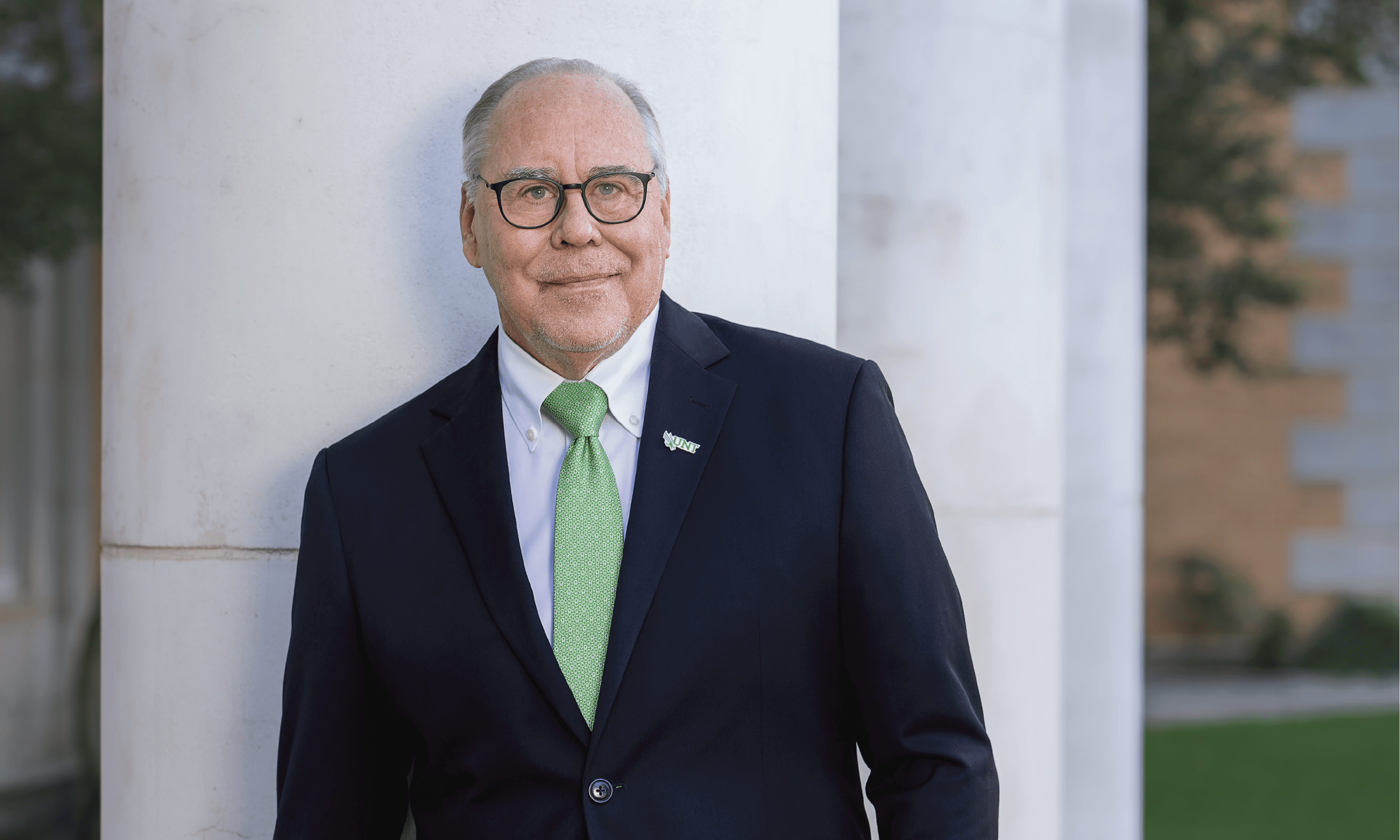
UNT President Neal Smatresk
Shocking as this is, Smatresk’s salary isn’t the highest. In 2019, U.S. News and World Report found the base pay of Texas A&M’s president was $900,000 (total pay of more than $1.3 million), and the base pay of the University of Houston’s president was more than $790,000 (total pay close to $1.4 million).
But there are more university positions funded by taxpayers. And at UNT, there has been bureaucratic growth according to organizational charts Texas Scorecard obtained (2015-2016 and 2022-2023). These track who reports directly to Smatresk, such as the provost and vice president for academic affairs.
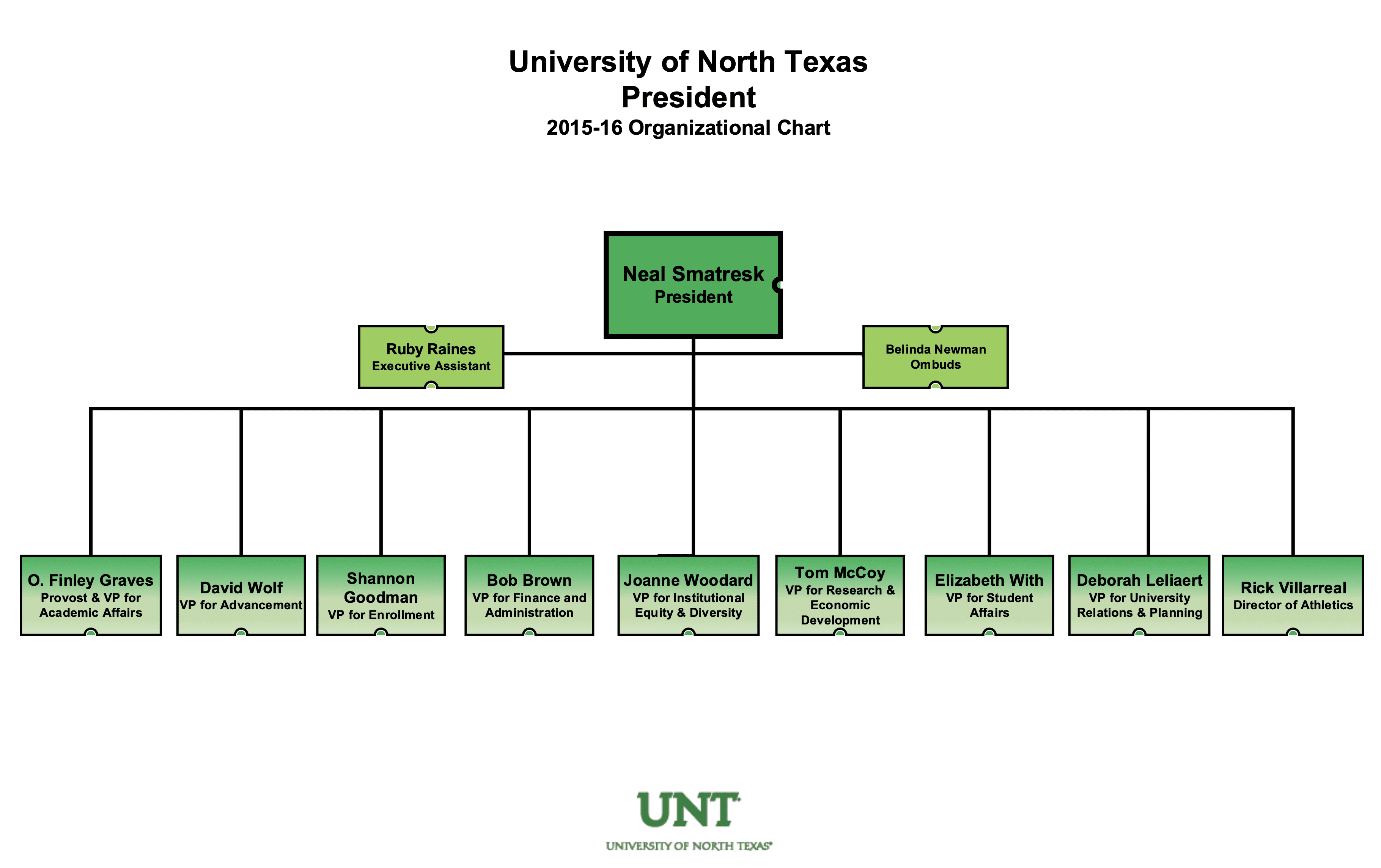
Source: University of North Texas
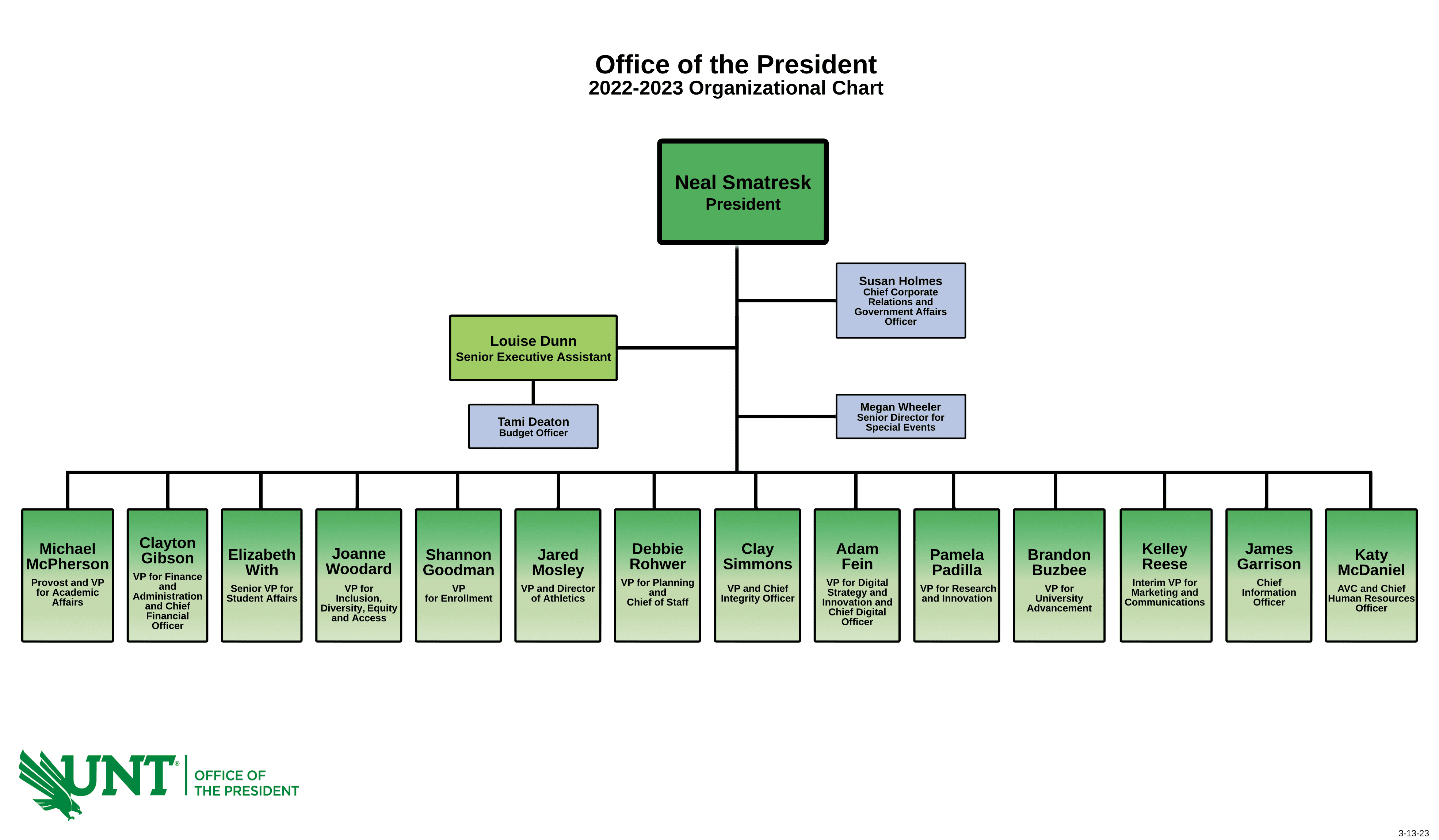
Source: University of North Texas
In 2016, the provost and vice president for academic affairs position was held by O. Finley Graves, and his salary was close to $340,000. In 2022, Michael McPherson held this post, and his salary was $390,000. That’s more than a 14 percent increase.
There’s another position that 2023 legislation should affect. In 2016, Joanne Woodward was vice president for Institutional Equity & Diversity at UNT, and her salary was $205,000. In 2022, she was VP for Inclusion, Diversity, Equity, and Access. Her salary then was more than $229,000—roughly 11 percent higher. She also reports directly to Smatresk.
In light of the 2023 DEI ban passed by state lawmakers, Texas Scorecard asked Smatresk what would happen to the department and Woodward. No response was received before publication.
Money-guzzling growth was found nearby. Compare these organizational charts Texas Scorecard obtained from Texas Woman’s University in Denton, Texas. The first is one from January 2016.
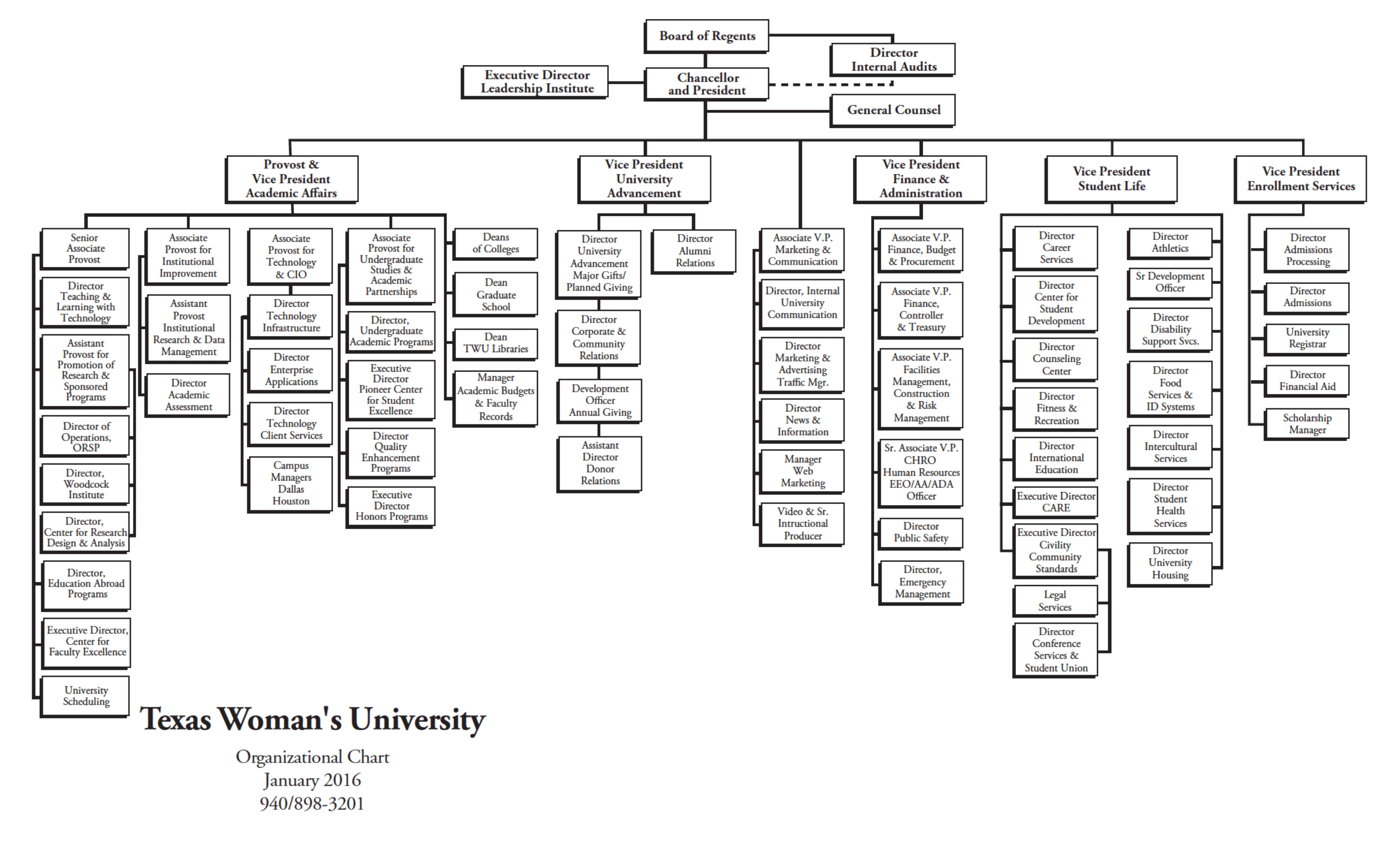
Source: Texas Woman’s University
Compared with the first chart, their July 2022 chart shows explosive growth.
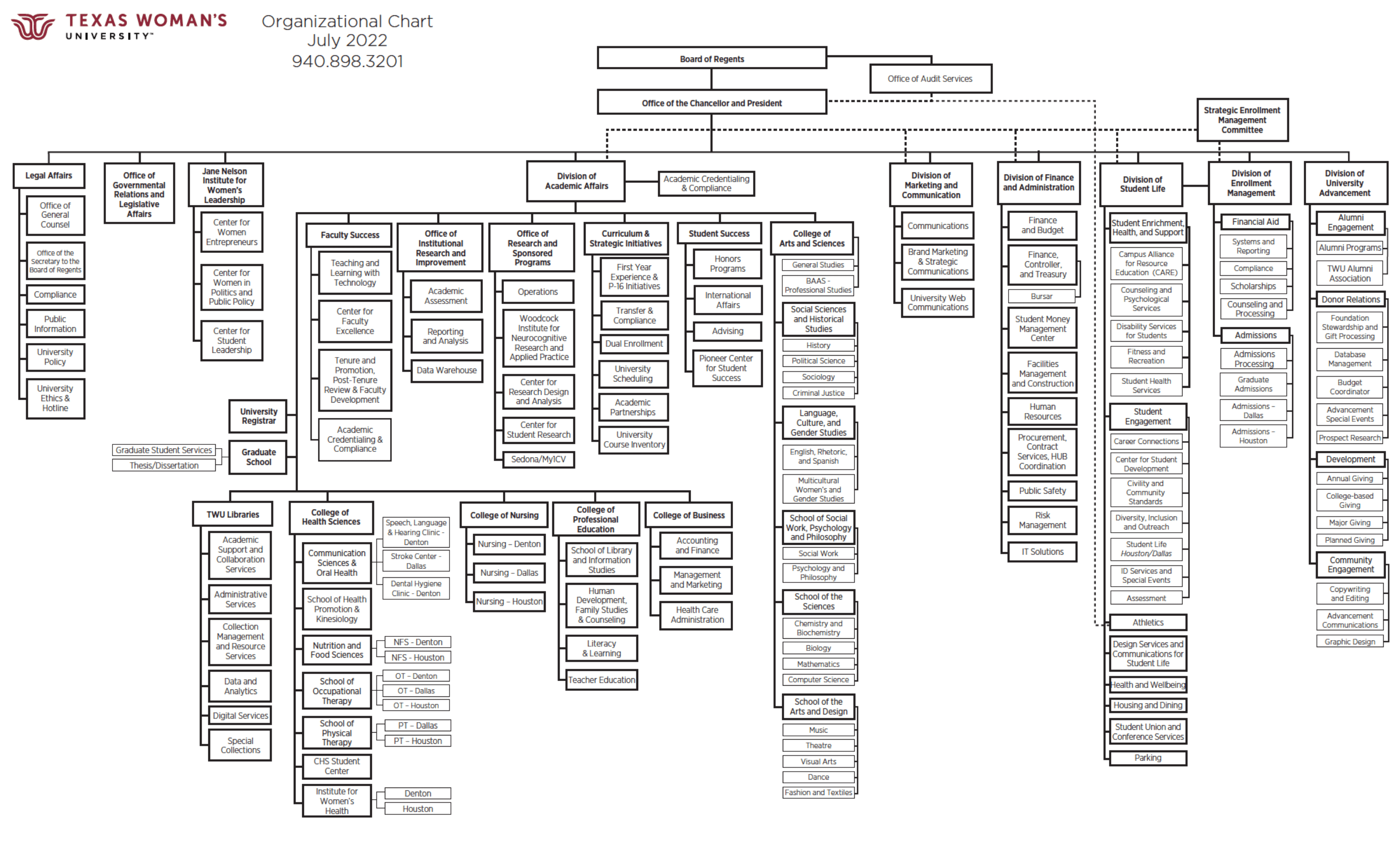
Source: Texas Woman’s University
TWU’s total enrollment in the Fall 2016 semester was more than 15,000 students. In Fall 2022-2023, it was close to 16,000. Somehow, that increase justified this organizational explosion.

Left: University of North Texas; Right: Texas Woman’s University
It can even pay to you reach a certain level in government higher education. THECB reported the average salaries in Fiscal Year 2016 for professors ($121,147), associate professors ($82,825), and assistant professors ($72,461). In Fiscal Year 2022, the average salaries for all went up to $140,776, $94,960, and $84,993 (increases of more than 15 percent, 14 percent, and 17 percent, respectively).
If state education is a business, business is good except for those paying for it—both taxpayers and students. A Forbes May 2021 piece discussed how massive grade inflation in American universities has led to higher grades despite students doing less work. Many graduates are also “severely underemployed,” while the cost of higher education has grown beyond its worth. According to this piece, a key part of this failure is that Americans are entering higher education “less prepared” than those in other countries or, “in some respects,” prior Americans.
A Gallup poll published July 11, 2023, reported that Americans’ confidence in higher education had gone from 57 percent in 2015 to 36 percent. “While Gallup did not probe for reasons behind the recent drop in confidence, the rising costs of postsecondary education likely play a significant role,” the report stated.
Yet, those working in government schools live well despite the decline in student achievement.
K-12
Scandals at independent school districts across Texas have been exposed since the 2020 government lockdowns and restrictions.
An examination of multiple ISDs finds frustrated parents are funding high salaries for the administrators actively fighting against them.
Located outside of Austin, Round Rock ISD has been a center of controversy due to its treatment of parents and taxpayers. Most school trustees also protected Superintendent Hafedh Azaiez, who has been accused of domestic violence. Local taxpayers are paying Azaiez $350,000, according to the latest data from the Texas Education Agency. Compared with the 2016 salary of his predecessor, Steve Flores, at $286,684, that equals a 22 percent spike. However, TEA data as of publication shows that only 64 percent of students performed at or above their grade level in all subjects in the State of Texas Assessments of Academic Readiness (STAAR) test.
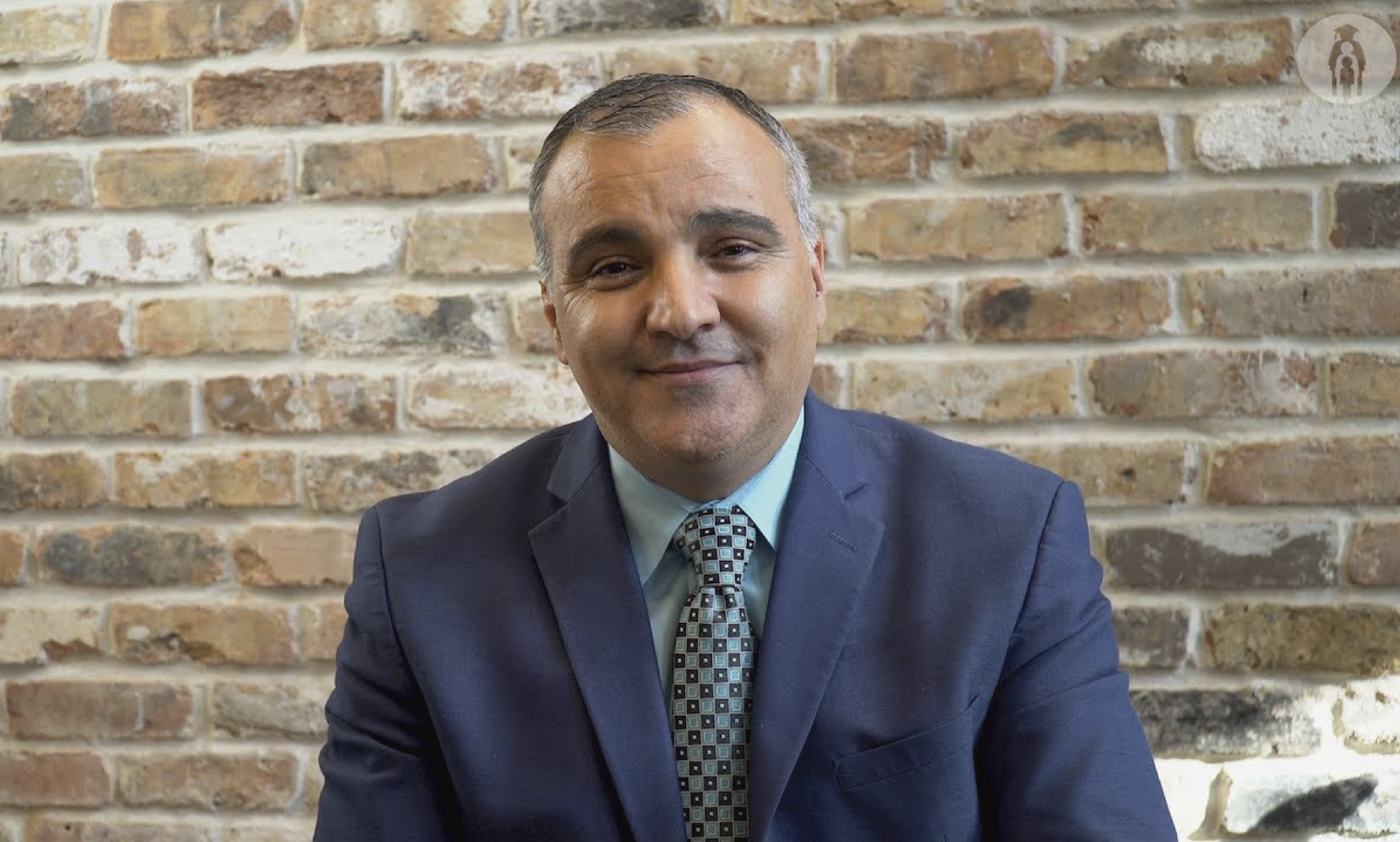
Round Rock ISD Superintendent Hafedh Azaiez
There are more examples of unbalanced compensation increases.
Fort Worth ISD has made headlines over their attempts to push controversial sex education materials and critical race theory on students. They also have had sexually explicit material in their school library. As recently as July 11, 2023, activist Carlos Turcios found such materials were still present. Still, citizens have arisen and forced change. In one instance, Fort Worth ISD Board Secretary CJ Evans announced in April 2023 that they were ending the district’s divisive Equity & Excellence Department.
Here too, taxpayers have been funding the lucrative salaries of those fighting them. In 2016, the salary of Sherry Breed, chief of equity and excellence, was more than $183,000. There was no information in the records we received on the salary for this position in 2022.
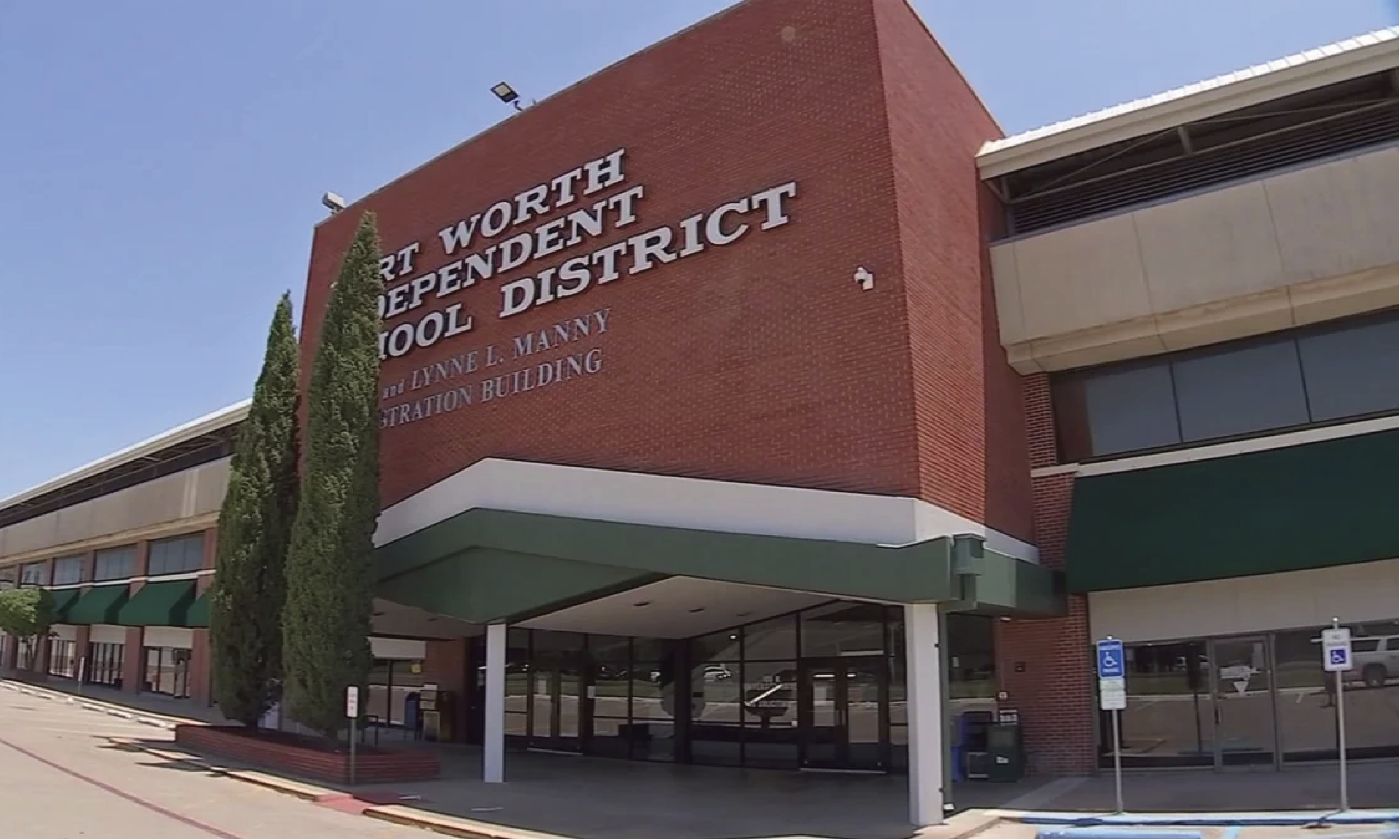
Fort Worth ISD
There are more plush salaries. Superintendent Angelica Ramsey, who has supported equity policies and critical race theory before coming to the district, was paid $335,000 in 2022. In 2016, her predecessor Kent Scribner, who was forced to leave after consistent citizen outcry, had a salary of $330,000. The next highest salary in 2022 was that of Deputy Superintendent Karen Molinar, at close to $260,000. Fort Worth ISD’s Chief of Academics Marcey Sorensen was paid more than $180,000 in 2022, while her predecessor was paid more than $183,000 in 2016.
For all this, data from the Texas Education Agency reports that only 32 percent of Fort Worth ISD students performed at their grade level or above in all subjects on the STAAR test. According to the establishment-backed Fort Worth Report, Fort Worth ISD’s proposed 2023-2024 school year budget runs a more than $46 million deficit. Yet, the district is still planning to have taxpayers shell out a 3 percent across-the-board pay raise. To make up the difference, the district reportedly is planning to tap into its savings of more than $341 million.
Nearby Dallas ISD also has a telling story. They became infamous in 2021 for their tyrannical mask mandates. That same year, a recording was provided to Texas Scorecard of what seemed to be a man promoting controversial sexual theory to minors in a school club. It was alleged the man in the recording was a Dallas ISD teacher. This year, Twitter account Libs of Tik Tok condemned the district for providing children with sexually explicit books.

Dallas ISD
TEA reports that current Dallas ISD Superintendent Stephanie Elizalde’s salary is $338,000. Her predecessor in 2016 had a salary of $335,000. At that time, Dallas ISD records show Elizalde was the chief schools officer and was paid a $200,000 salary. In 2022, district taxpayers paid Shannon Trejo, their chief academic officer, more than $221,000.
TEA data available at the time of publishing showed that 41 percent of district students performed at their grade level or above in the STAAR test.
Yet in 2022, Dallas ISD found it important to pay a more than $202,000 salary to a deputy chief over the Office of Racial Equity. They also paid a close to $199,000 salary to Leslie Williams, the deputy chief of Minority Women Business Enterprises. In 2016, they paid the director of that department, Annie Holmes-Partee, close to $95,000. In 2022, they paid more than $217,000 to Libby Daniels, the district’s chief communications officer.
Similar largesse is seen elsewhere.
TEA data available as of publication showed only 29 percent of San Antonio ISD students performed at their grade level or above. But district records show in 2022, Superintendent Jaime Aquino was paid more than $324,000—15 percent higher than his predecessor Pedro Martinez. Deputy Superintendent Patricia Salzmann was paid 33 percent more than her predecessor, Matthew Weber ($204,001 and $153,314.32, respectively). The largest increase in the data Texas Scorecard reviewed was for Chief Info Tech & Acct. Officer Kenneth Thompson. In 2022, he was paid more than $196,000. In 2016, Chief Info Officer Patrica Holub was paid more than $113,000—a roughly 73 percent difference.
El Paso ISD has been in the spotlight as early as 2011 for wasting taxpayers’ money.
This trend appears to be continuing. Records from the district show that from 2016 to 2022, while the superintendent’s pay decreased 9 percent ($348,827 to $320,000), this was not true of all positions. Deputy Superintendent Vincent Sheffield’s pay exploded more than 29 percent ($167,369 to $217,042). Their chief academic officer in 2022, Jaqueline Kennedy, was paid more than 22 percent more than the district’s 2016 chief academic & innovation officer, Karen Blaine ($129,920 to $158,636).
Meanwhile, data from TEA showed only 44 percent of students performed at their grade level or above in the STAAR test.
Most shocking were records obtained from Pflugerville ISD, located just outside of Austin. These compared the salaries of certain administrators from 2016 and 2021-2022. The 2016 records are contained in a .msg file, which failed to upload to our website.
Superintendent Douglas Killian’s pay is more than 86 percent higher than his 2016 counterpart, Alex Torrez, Ph.D. ($317,806.66 and $170,832.50, respectively).
These weren’t the only differences. Chief of Staff Troy Galow’s pay grew more than 75 percent from when he was a deputy superintendent in 2016 ($119,498.34 to $209,389.35). According to the district’s 2016 and 2022 organizational charts, it appears the position of deputy superintendent was renamed as “chief of staff.” Records also indicate Galow was replaced as chief of staff in 2022 by J. Brandy Baker, whose salary ($168,296.14) is more than 40 percent higher than Galow’s 2016 pay.
The most shocking difference appears to be in the communications department. Steve Scheffler was the district’s communications officer in 2016, with a salary of $44,722.00. Comparing the district’s 2016 and 2022 organizational charts, this position appears to have been replaced with chief communications officer, who in 2022 is listed as Tamra Spence with a salary of $140,745.88. That is more than 214 percent more than Scheffler’s.
For all this, TEA’s data showed that only 46 of Pflugerville ISD students performed at their grade level or above on the STAAR test.
The district was recently highlighted when a school district police officer was arrested for allegedly soliciting a minor.
Texas Education Agency
With these outsized administrative salaries in multiple low-performing school districts, a question should be asked of the state agency that claims it “improves outcomes for all public school students in the state by providing leadership, guidance, and support to school systems.”
In response to our open records request, TEA produced records for the salaries of some of its top administrators in 2022. Commissioner Mike Morath’s total salary is close to $270,000. All deputy commissioners’ pay in 2022 combined equaled more than $1.6 million of taxpayer monies.
Another highly paid job at TEA is the position of Grant Compliance & Administration. In 2022, Lyndal Green was paid more than $230,000 for this job.
As has been seen in universities and other state agencies, there’s been an explosion of positions at TEA. Compare their 2016 and 2022 organizational charts.
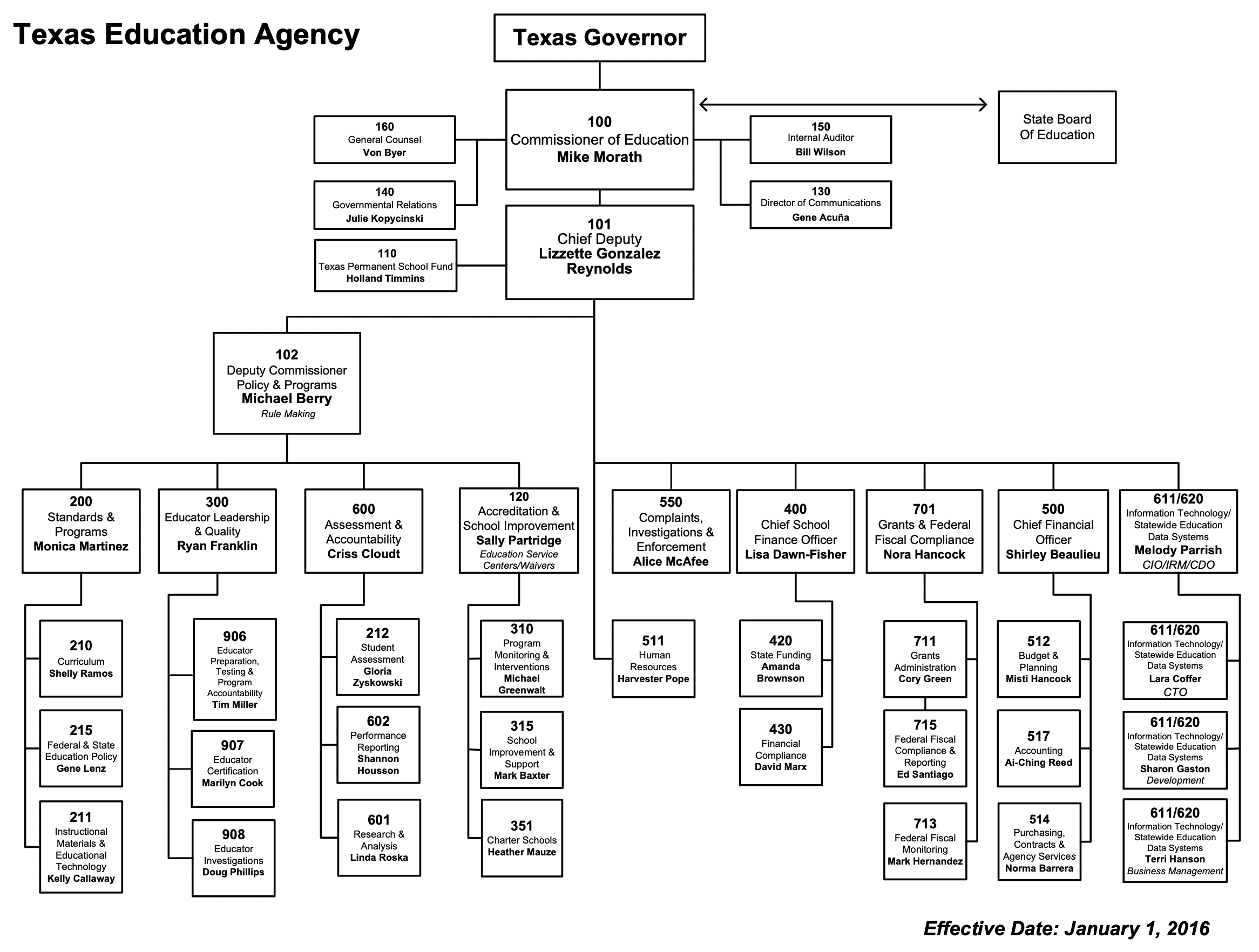
Source: Texas Education Agency
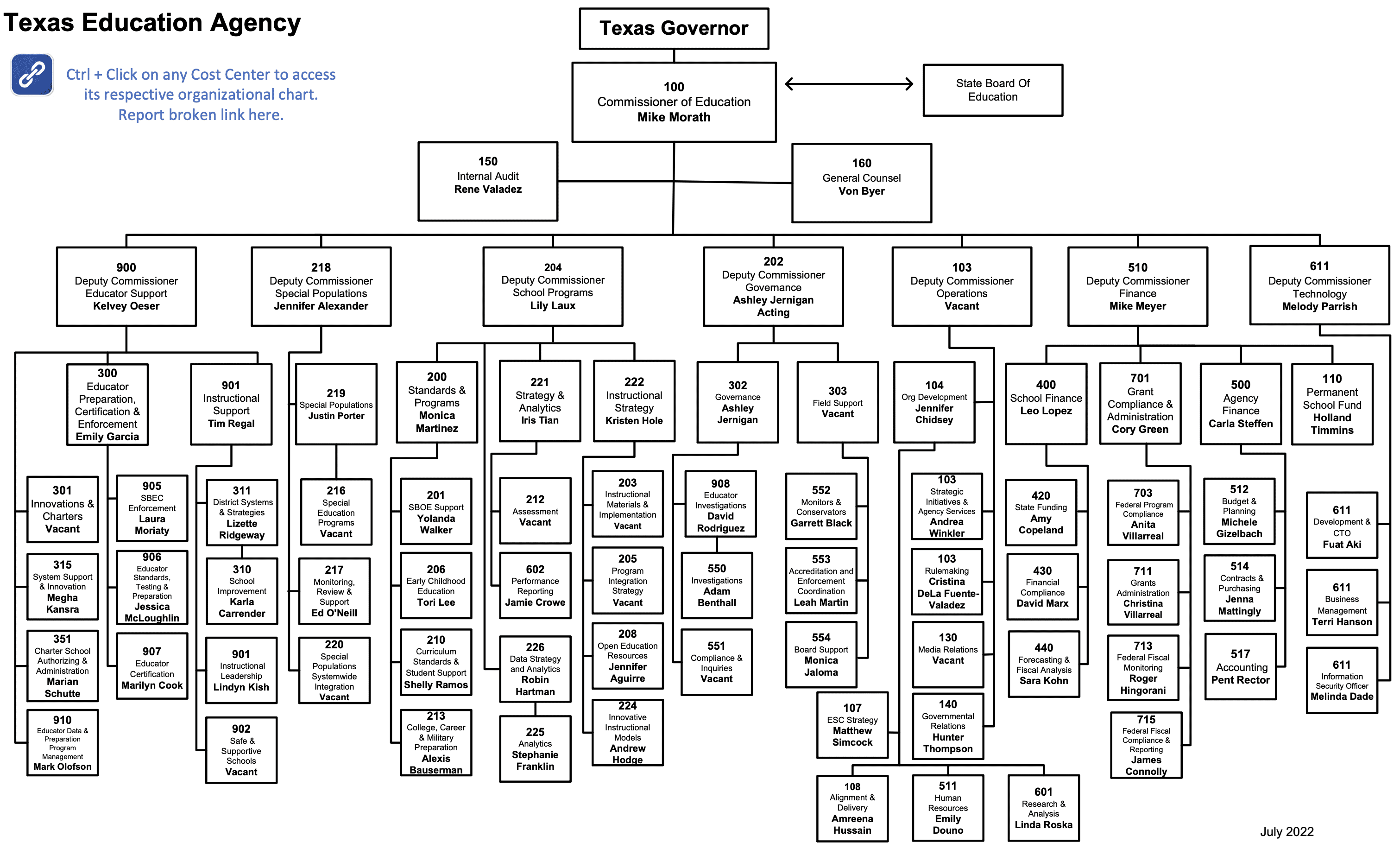
Source: Texas Education Agency
And still under TEA’s watch, Texans have a disappointing and subversive government education system.
Return to Public Service
Every legislative session, the state government school lobby demands more taxpayer money from state lawmakers. Universities are reportedly inflating grades, and multiple K-12 schools in Texas are failing to provide students with a quality education. In both arenas, woke indoctrination is taking place.
“You can see these are very troubling numbers when contrasted with the huge compensation we’re providing these top officials,” Quintero said of excessively high superintendent salaries. “It’s very clear we’re not receiving any sort of bang for the buck.”
This investigative series has also focused on the salary explosion of state and other local governments. Meanwhile, taxpayers struggle as those in government get richer.
“Unfortunately, I think many of our public sector administrators feel entitled to annual salary increases and other generous benefits that have kind of built up over the years,” Quintero said. “It’s no longer tied to performance. It’s because I’m here and I deserve it. I think that that mindset has become fairly widespread throughout much of the public sector.”
How do we return to an attitude of public service in government? Quintero recommends instituting a merit-based system. “One of the objectives that we’re trying to accomplish here at the [Texas Public Policy] Foundation is to move toward more of a performance-based compensation model where we’re rewarding high-value employees for their productivity and value,” he said. “We want to try to get away from this one size-fits-all pay increase model that seems to have taken hold, and that is rewarding unproductive employees who are not performing up to the task.”
Economist Vance Ginn argues that there must also be cuts in spending. “It’s almost like we’re in a period of no return the way that these wages and salaries are growing at such a faster rate than Texans’ wages and salaries,” he said. “Until we can limit government spending at the state level, at the city, county, at the ISDs … the wages and salaries will continue to go up.” He suggested that maybe rules could be put in place on how high wages and salaries could be.
One solution that Quintero said TPPF has supported is for state lawmakers to cap state and local government salaries so they can’t be higher than the governor’s—or only a certain amount higher. “I think there is a strong argument to be made that no state or local government employee should earn more than the governor of Texas.” He also suggested caps on spending increases. “The state budget is currently subject to at least five different spending limits, four of which are constitutional, one of which is statutory. Local government budgets are subject to none of those,” he explained. “I think it’s time for the Texas Legislature to create a comprehensive local government spending limit that puts downward pressure on the rate of increase.”
Such ideas should be considered soon, as more economic trials are on the horizon for taxpayers.




